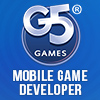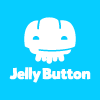Sergey Batishchev is an indie game developer and has been an enterprise Java developer and tech lead for more than 12 years. Still, games and game development have always been his hobby. After the successful launch of his Gluey game series, he is dedicating himself more on indie game development. Batishchev strives to make simple, polished and fun Flash and mobile games that appeal even to most casual gamers.
Gluey is a very simple action puzzle game. You just click the blobs, they disappear and you earn points. Large blob clusters give you bigger score bonuses. And, of course, it is seasoned with multiple levels, modes and power-ups. The idea for Gluey originated from an unusual source. Back in my university years, the demoscene was at its peak. I was amazed by the graphical effects in the demos and I wanted to learn how to do the same. So I spent many hours with my Watcom C++ compiler trying to code fire, fluid, and smoke.
Back in 2009, game development was purely a hobby for me. But one day I thought: Wouldn’t it be cool to create the simplest game possible, based purely on a rendering technique - like fire, liquid or particles? Surprisingly, no one made a match-3 or click group to clear-game with liquid blobs at that time! All other elements came quite naturally. I decided to use simple click group to clear-mechanics, as my friends really enjoyed games like that on their Windows 6.5 phones. It was also intuitive for the blobs to follow real physics, not just gridlines as in classic match-3. Within a couple of days, the prototype was finished. Although still in its early alpha-stages, the basic gameplay mechanic was already quite clear.
Art was a weak point for my hobby games before Gluey. Psychologically it was hard for me to fork out real money to hire an artist and a musician. I first needed to prove to myself that my games could generate some revenue. In retrospect that was not very smart choice. If you are a part time indie, you really should treat your home game development just like other expensive hobbies that you enjoy!
Luckily my previous game Cyberhorde generated about $1.5K in primary and non-exclusive licenses, so I posted a job offer for art design for Gluey. Bogdan Ene responded very quickly. Within my tough budget constraints he managed to create compelling characters and nice visual style. The visual design was completely done in a matter of days; there was no need to send anything back for revisions. After that, it took me about 6 calendar weeks (working through the weekends and evenings) to complete the rest of the game, which included levels, power ups, bonuses and transition screens.
Sponsorship and Release
Gluey attracted good attention from sponsors on FGL – 28 bids. I went with king.com for the primary sponsorship of this game. It was my first game with 5-digit primary offer and, to this day, my biggest success. The game met king.com’s expectations. It hit Kongregate and Newgrounds frontpages and spread quite well. To this date, the viral version has generated 14 million views. Unfortunately, ads were not allowed, but game did attract quite a lot of non-exclusive licensing offers.

What Went Right with Gluey
Being on a tight budget means you have limited possibilities. This turned out to be a positive thing: it pushed me to only focus on the important things. So the game was very light on content: only 16 levels, which calculates to about 20 minutes of gameplay (although some players replayed the game a lot). In retrospect, it was a good choice to limit the number of levels. If you don’t have time or money to add unique content, don’t just add same-looking levels. It is better to have people comment “Too short, needs more levels” on your game, than receiving comments like “Got bored on level 14”.
Another thing that went great was the way the blob mechanics felt. They were smooth, polished, and natural. If we compare them to actual droplets on a surface, we can see three core similarities:
- All blobs leave a trail behind, as if they are sliding on the surface with traction.
- Actual droplets cannot touch without merging. So blobs of different color repel from each other and from the edge to look natural.
- Sharp boundary around blob stressed how blobs merge and break apart.
I resisted the temptation to make the gameplay time-bound, like a lot of other puzzle games. Adding a time constraint is the easiest way to add some challenge to an action puzzle. However, players liked the fact that they had to act timely so that blobs structures do not slide apart. They felt smart for inventing this technique, instead of being forced to it by a timer. They also liked the fact that after a short burst of clicks, they were able to relax for some time and figure out the next move, instead of being bugged by the ticking clock.
What Went Wrong with Gluey
Despite all the good things about Gluey, it was still a bit short. It looks like the sweet spot for a casual Flash puzzle is 30-45 minutes. Many players complained the game ended too abruptly, and down-voted the game for that reason. Yes, Gluey did feature the unlockable Zen mode. But this mode did not match the players’ expectations. The idea for the Zen mode was that for each cluster of n blobs, you get n-1 blobs back. So a Zen game ended pretty quickly (gameplay lasting only 2-3 minutes) and did not feel as an endless survival challenge.
Completing levels in Gluey was based on a simple and quite artificial premise: Earn score x to complete the level. Once you got to score x, your only motivation is reaching the top of the highscore table, which is not a very strong motivation. The game did not have any stars to rate the players’ performance on some level.
The sequel: Gluey 2!
As Gluey 1 was a success, I decided to go indie full time and started working on Gluey 2. The sequel was a much longer project (9 months compared to 6 weeks). I wanted to add lots of power-ups and polish every detail. Besides, I wanted to address the common complaint about “reach score x” as meaningless goal. The main mode of Gluey 2 was to survive the flow of blobs, a bit like a Tetris.
I was happy with the art of Gluey 1, but I felt I had to make the sequel totally fresh and new. So the game visuals were also redesigned from scratch! RetroStyleGames did a great job at keeping the game’s atmosphere, but making it look even more smooth and polished.
The banjo music track for Gluey 1 was very fun and recognizable, but probably a bit too sharp and repeatable for a casual game that you play often. People tend to either love it or hate it. Francesco D’Andrea created a much more subtle music track for Gluey 2.
Overdoing and Overthinking
Gluey 2 did okay when it was released. The primary license price tag was roughly the same as for Gluey 1 and the game attracted a lot of non-exclusive license requests. But the game did suffer a lot from overdoing and overthinking! In fact, the many changes disappointed the fans. Many claimed that the new gameplay was mindless arcade; they missed their clean and simple “Get score X” puzzles. Many people even wanted the stock banjo sound track back from Gluey 1, which quite a few players originally disliked and characterized as too sharp and distracting.
The new gameplay turned out to be creative, but very counterintuitive! When the blob flow comes, your first instinct is to click as fast as you can. But that’s exactly what you should not do in Gluey 2. Instead you have to carefully create huge clusters of blobs to save on the number of clicks you make. Numerous people left the game frustrated for this reason.
However, both Gluey 1 and Gluey 2 were successes for me. The total revenue from the games is approximately $68K.
Lesson 1: Target the player’s intuition
Players feel smart if they can use their intuition and real life experience to predict behavior of the game. This is especially pleasing if the behavior itself is not trivial. For example, people immediately realized what the Shuffle Powerup is and does. Everywhere on the forum and in the comments it was called the Rubic cube powerup. Another example of this is sinking blobs. Both from real life and from arcade games players know that drowning is fatal. So it is relatively intuitive that you should keep blobs out of deep water. Only problem here is that players have no way to relate blob density to real world objects. They have no way to predict if the blobs would drown or float!

My partners used a similar metaphor for the iOS port, where they made the liquid look like green acid. Even though acid is dangerous and maybe out of place in a casual puzzle game, it worked really well. Everyone clearly knows from movies and comics that sinking in green acid is the worst thing that can ever happen.
Going against intuitive behavior is dangerous, and it can go unnoticed until the actual release. Pipes in real life feed water all the time (or at least when a valve is open). It turned out it is really hard to grasp that removing a blob on the screen actually releases more blobs from the pipe.

Lesson 2: A sequel does not need to be a revolution
Every little thing I changed in a sequel disappointed at least one player! People liked the original game for a reason. They wanted more of the same type of entertainment in Gluey 2, even though they didn’t want it to look and feel exactly the same.
From now on, my sequels will have…
● the same art style, just more variation and improved quality;
● the same music style, but evolved;
● the same pace;
● an evolved gameplay, not a replacement.
If I ever want to break those rules, I will be making spin-offs of the original. For example, arcade games in this Gluey universe can be Gluey Jumpers or Gluey Shooters, not Gluey 3.
Lesson 3: The Flash game licensing model is still viable
Casual single player games for portals can still pay the bills for an indie game developer. A quality casual game with solid gameplay, professional art will get sponsored and licensed. If I limit the development cycle to less than 4 months, the licensing fees in the first 6 months are likely to cover my costs and finance risky mobile projects.

Non-exclusive sales worked great for my type of games. They can occur years after initial release. Now I am even more reluctant to accept fully exclusive deals for my future games.
Recently, Gluey was ported to iOS. In the mean time, Sergey is working on Gluey 3. To see what else he has been up to, check out his website or Twitter (@sergebat).
Comments










